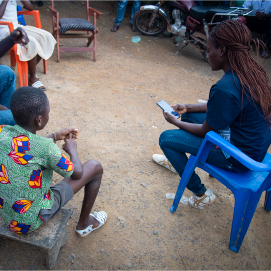Breaking Chains, Changing Lives: ETG | Beyond Beans Tackles Child Labour in Supply Chains.
June 29, 2023
Effective Strategies to Combat Child Labour
The chocolate industry has a long history of child labour, especially in West Africa, where more than 70 per cent of the world’s cocoa is produced and where the income of smallholder cocoa farmers on cocoa still is below the living income benchmark.
Child labour is a complex issue with many underlying causes which are closely tied to structural poverty and gender disparity.
Most of the child labour occurring on cocoa farms is children supporting their own families due to the struggles of living in poverty, where families have limited resources and an extra pair of hands can make a difference to their livelihood. A lack of awareness of the harms that child labour can cause or of the long-term benefits of formal education, as well as persistent gender inequality, also contributes to the ongoing practice.
The increasing pressure on cocoa companies to remediate individual cases puts a focus on short-term, easily quantifiable solutions such as the provision of school kits, birth certificates, and school fees. While these initiatives offer some level of assistance, they do not establish the fundamental collaborative efforts necessary to promote enduring community development in the presence of systemic poverty.
The solution is, therefore, a multifaceted and tailor-made approach which tackles child labour in various ways. ETG | Beyond Beans has developed a more bottom-up and community-driven approach to tackle child labour, with a focus on income-generating activities, awareness raising, and gender empowerment at the household level.
VSLA-CHILD: Tackling the roots of child labour in cocoa communities
The VSLA-CHILD project is an ETG | Beyond Beans child labour remediation initiative that aims to tackle child labour in cocoa-producing communities through a community-driven approach.
VSLA-CHILD is made up of three core elements that build on each other: Village Savings and Loan Associations, Gender Action and Learning System, Child-Household Intervention for Learning & Development. Together, these elements are designed to create a bottom-up community-based impact by improving access to finance, empowering women, and addressing the root causes of child labour.
The project seeks to increase the access of farmers to microcredit, improve their savings culture and income diversity, and support farming households to develop self-help measures to protect children and remediate child labour using bottom-up approaches.
Grace is a cocoa farmer from Nyamebekyere, Ahafo Ano, in the South East District of Ghana. In her community, she has been one of the ‘champions’ of a VSLA-CHILD group, receiving training that she brings back to her group members.
“As a VLSA champion, it is my duty to teach my group members to stop using their children for work which is too much for them,” she explains, “The rights of children should be respected.”
Child Labour Monitoring Tool
ETG | Beyond Beans has developed its own Child Labour Monitoring Tool (CLMT), where both child and forced labour indicators were derived from an extensive literature study from existing survey tools and databases.
The CLMT creates profiles of communities, households, farmers, their children and local schools, all of which are integrated into our data-collection platform, Mergdata. This provides insight into the risk of child labour in each community and helps to identify what support is needed to remediate specific instances of child labour.
The tool also combines two different types of sensitisation sessions: one for communities and one for households. These sessions raise awareness of practices dangerous for children and spark discussion on how families can protect their children and support them in going to school.
Topics covered during child labour awareness sessions include:
- The definition and overview of child labour and child work
- The effect of child labour on children
- The importance of education
- Emphasis on light work
- The difference between hazardous work and light work
- In all instances of identified child labour, careful monitoring and follow-up surveys are conducted.
Besides awareness-raising sessions, remediation interventions are tailored to each community and individual situation. This active process ensures the identification, referral, protection, and prevention of child labourers across the community, household, and farmer levels. Today, we cover more than 50,000 households across Côte d’Ivoire, Ghana, and Nigeria.
 Aquah Bentil from Ghana joined the VSLA program two years ago. She said: “We used to do lots of work when we were young, but when the programme educated us on the types of child work, I realised that giving children a lot of work makes them perform poorly at school. With two years in the VSLA program, I can now support my children with their school materials and the things they need for their well-being.”
Aquah Bentil from Ghana joined the VSLA program two years ago. She said: “We used to do lots of work when we were young, but when the programme educated us on the types of child work, I realised that giving children a lot of work makes them perform poorly at school. With two years in the VSLA program, I can now support my children with their school materials and the things they need for their well-being.”
The VSLA-CHILD program has the potential to effectively combat child labour in the cocoa sector. By providing access to financial resources and support within the community, families can break free from the cycle of poverty that often forces children to work on cocoa farms. Through women’s empowerment and economic stability, we create a pathway which prioritises education and reduces the risk of child labour.


 YOUR TRUSTED PLANT-BASED FOOD PARTNER
YOUR TRUSTED PLANT-BASED FOOD PARTNER
